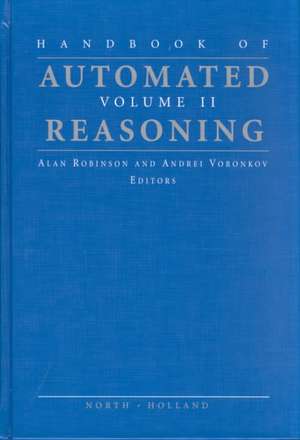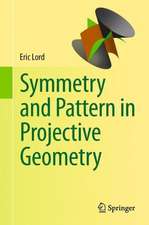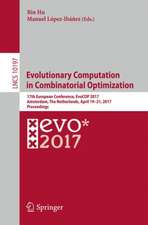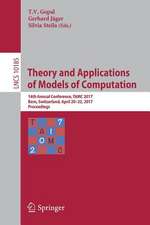Handbook of Automated Reasoning: Handbook of Automated Reasoning, cartea II
Editat de Alan J.A. Robinson, Andrei Voronkoven Limba Engleză Hardback – 21 iun 2001
| Toate formatele și edițiile | Preț | Express |
|---|---|---|
| Hardback (2) | 1157.47 lei 5-7 săpt. | |
| ELSEVIER SCIENCE – 21 iun 2001 | 1157.47 lei 5-7 săpt. | |
| ELSEVIER SCIENCE – 21 iun 2001 | 1586.46 lei 6-8 săpt. |
Preț: 1157.47 lei
Preț vechi: 1311.36 lei
-12% Nou
Puncte Express: 1736
Preț estimativ în valută:
221.51€ • 240.53$ • 186.07£
221.51€ • 240.53$ • 186.07£
Carte tipărită la comandă
Livrare economică 15-29 aprilie
Preluare comenzi: 021 569.72.76
Specificații
ISBN-13: 9780444508126
ISBN-10: 0444508120
Pagini: 1188
Dimensiuni: 165 x 240 x 60 mm
Greutate: 2.07 kg
Editura: ELSEVIER SCIENCE
Seria Handbook of Automated Reasoning
ISBN-10: 0444508120
Pagini: 1188
Dimensiuni: 165 x 240 x 60 mm
Greutate: 2.07 kg
Editura: ELSEVIER SCIENCE
Seria Handbook of Automated Reasoning
Cuprins
Part V. Higher-order logic and logical frameworks.
Chapter 15. Classical Type Theory (Peter B. Andrews).
1. Introduction to type theory.
2. Metatheoretical foundations.
3. Proof search.
4. Conclusion.
Bibliography. Index.
Chapter 16. Higher-Order Unification and Matching (Gilles Dowek).
1. Type Theory and Other Set Theories.
2. Simply Typed &lgr;-calculus.
3. Undecidability.
4. Huet's Algorithm.
5. Scopes Management.
6. Decidable Subcases.
7. Unification in &lgr;-calculus with Dependent Types.
Bibliography. Index.
Chapter 17. Logical Frameworks (Frank Pfenning).
1. Introduction.
2. Abstract syntax.
3. Judgments and deductions.
4. Meta-programming and proof search.
5. Representing meta-theory.
6. Appendix: the simply-typed &lgr;-calculus.
7. Appendix: the dependently typed &lgr;-calculus.
8. Conclusion.
Bibliography. Index.
Chapter 18. Proof-Assistants Using Dependent Type Systems (Henk Barendregt, Herman Geuvers).
1. Proof checking.
2. Type-theoretic notions for proof checking.
3. Type systems for proof checking.
4. Proof-development in type systems.
5. Proof assistants.
Bibliography. Index. Name index.
Part VI. Nonclassical logics.
Chapter 19. Nonmonotonic Reasoning: Towards Efficient Calculi
and Implementations (Jurgen Dix, Ulrich Furbach, Ilkka Niemela).
1. General Nonmonotonic Logics.
2. Automating General Nonmonotonic Logics.
3. From Automated Reasoning to Disjunctive Logic Programming.
4. Nonmonotonic Semantics of Logic Programs.
5. Implementing Nonmonotonic Semantics.
6. Benchmarks.
7. Conclusion.
Bibliography. Index.
Chapter 20. Automated Deduction for Many-Valued Logics
(Matthias Baaz, Christian G. Fermuller, Gernot Salzer).
1. Introduction.
2. What is a many-valued logic?
3. Classification of proof systems for many-valued logics.
4. Signed logic: reasoning classically about finitely-valued logics.
5. Signed resolution.
6. An example.
7. Optimization of transformation rules.
8. Remarks on infinitely-valued logics.
Bibliography. Index.
Chapter 21. Encoding Two-Valued Nonclassical Logics in Classical Logic (Hans Jurgen Ohlbach, Andreas Nonnengart, Maarten de Rijke, Dov M. Gabbay).
1. Introduction.
2. Background.
3. Encoding consequence relations.
4. The standard relational translation.
5. The functional translation.
6. The semi-functional translation.
7. Variations and alternatives.
8. Conclusion.
Bibliography. Index.
Chapter 22. Connections in Nonclassical Logics (Arild Waaler).
1. Introduction.
2. Prelude: Connections in classical first-order logic.
3. Labelled systems.
4. Propositional intuitionistic logic.
5. First--order intuitionistic logic.
6. Normal modal logics up to S4.
7. The S5 family.
Bibliography. Index.
Part VII. Decidable classes and model building.
Chapter 23. Reasoning in Expressive Description Logics (Diego Calvanese, Giuseppe De Giacomo, Maurizio Lenzerini, Daniele Nardi).
1. Introduction.
2. Description Logics.
3. Description Logics and Propositional Dynamic Logics.
4. Unrestricted Model Reasoning.
5. Finite Model Reasoning.
6. Beyond Basic Description Logics.
7. Conclusions.
Bibliography. Index.
Chapter 24. Model Checking (Edmund M. Clarke, Bernd-Holger Schlingloff).
1. Introduction.
2. Logical Languages, Expressiveness.
3. Second Order Languages.
4. Model Transformations and Properties.
5. Equivalence reductions.
6. Completeness.
7. Decision Procedures.
8. Basic Model Checking Algorithms.
9. Modelling of Reactive Systems.
10. Symbolic Model Checking.
11. Partial Order Techniques.
12. Bounded Model Checking.
13. Abstractions.
14. Compositionality and Modular Verification.
15. Further Topics.
Bibliography. Index.
Chapter 25. Resolution Decision Procedures (Christian G. Fermuller, Alexander Leitsch, Ullrich Hustadt, Tanel Tammet).
1. Introduction.
2. Notation and definitions.
3. Decision procedures based on ordering refinements.
4. Hyperresolution as decision procedure.
5. Resolution decision procedures for description logics.
6. Related work.
Bibliography. Index.
Part VIII. Implementation.
Chapter 26. Term Indexing (R. Sekar, I.V. Ramakrishnan, Andrei Voronkov).
1. Introduction.
2. Background.
3. Data structures for representing terms and indexes.
4. A common framework for indexing.
5. Path indexing.
6. Discrimination trees.
7. Adaptive automata.
8. Automata-driven indexing.
9. Code trees.
10. Substitution trees.
11. Context trees.
12. Unification factoring.
13. Multiterm indexing.
14. Issues in perfect filtering.
15. Indexing modulo AC-theories.
16. Elements of term indexing.
17. Indexing in practice.
18. Conclusion.
Bibliography. Index.
Chapter 27. Combining Superposition, Sorts and Splitting (Christoph Weidenbach).
1. What This Chapter is (not) About.
2. Foundations.
3. A First Simple Prover.
4. Inference and Reduction Rules.
5. Global Design Decisions.
Bibliography. A Links to Saturation Based Provers. Index.
Chapter 28. Model Elimination and Connection Tableau Procedures
(Reinhold Letz, Gernot Stenz).
1. Introduction.
2. Clausal Tableaux and Connectedness.
3. Further Structural Refinements of Clausal Tableaux.
4. Global Pruning Methods in Model Elimination.
5. Shortening of Proofs.
6. Completeness of Connection Tableaux.
7. Architectures of Model Elimination Implementations.
8. Implementation of Refinements by Constraints.
9. Experimental Results.
10. Outlook.
Bibliography. Index. Concept index.
Chapter 15. Classical Type Theory (Peter B. Andrews).
1. Introduction to type theory.
2. Metatheoretical foundations.
3. Proof search.
4. Conclusion.
Bibliography. Index.
Chapter 16. Higher-Order Unification and Matching (Gilles Dowek).
1. Type Theory and Other Set Theories.
2. Simply Typed &lgr;-calculus.
3. Undecidability.
4. Huet's Algorithm.
5. Scopes Management.
6. Decidable Subcases.
7. Unification in &lgr;-calculus with Dependent Types.
Bibliography. Index.
Chapter 17. Logical Frameworks (Frank Pfenning).
1. Introduction.
2. Abstract syntax.
3. Judgments and deductions.
4. Meta-programming and proof search.
5. Representing meta-theory.
6. Appendix: the simply-typed &lgr;-calculus.
7. Appendix: the dependently typed &lgr;-calculus.
8. Conclusion.
Bibliography. Index.
Chapter 18. Proof-Assistants Using Dependent Type Systems (Henk Barendregt, Herman Geuvers).
1. Proof checking.
2. Type-theoretic notions for proof checking.
3. Type systems for proof checking.
4. Proof-development in type systems.
5. Proof assistants.
Bibliography. Index. Name index.
Part VI. Nonclassical logics.
Chapter 19. Nonmonotonic Reasoning: Towards Efficient Calculi
and Implementations (Jurgen Dix, Ulrich Furbach, Ilkka Niemela).
1. General Nonmonotonic Logics.
2. Automating General Nonmonotonic Logics.
3. From Automated Reasoning to Disjunctive Logic Programming.
4. Nonmonotonic Semantics of Logic Programs.
5. Implementing Nonmonotonic Semantics.
6. Benchmarks.
7. Conclusion.
Bibliography. Index.
Chapter 20. Automated Deduction for Many-Valued Logics
(Matthias Baaz, Christian G. Fermuller, Gernot Salzer).
1. Introduction.
2. What is a many-valued logic?
3. Classification of proof systems for many-valued logics.
4. Signed logic: reasoning classically about finitely-valued logics.
5. Signed resolution.
6. An example.
7. Optimization of transformation rules.
8. Remarks on infinitely-valued logics.
Bibliography. Index.
Chapter 21. Encoding Two-Valued Nonclassical Logics in Classical Logic (Hans Jurgen Ohlbach, Andreas Nonnengart, Maarten de Rijke, Dov M. Gabbay).
1. Introduction.
2. Background.
3. Encoding consequence relations.
4. The standard relational translation.
5. The functional translation.
6. The semi-functional translation.
7. Variations and alternatives.
8. Conclusion.
Bibliography. Index.
Chapter 22. Connections in Nonclassical Logics (Arild Waaler).
1. Introduction.
2. Prelude: Connections in classical first-order logic.
3. Labelled systems.
4. Propositional intuitionistic logic.
5. First--order intuitionistic logic.
6. Normal modal logics up to S4.
7. The S5 family.
Bibliography. Index.
Part VII. Decidable classes and model building.
Chapter 23. Reasoning in Expressive Description Logics (Diego Calvanese, Giuseppe De Giacomo, Maurizio Lenzerini, Daniele Nardi).
1. Introduction.
2. Description Logics.
3. Description Logics and Propositional Dynamic Logics.
4. Unrestricted Model Reasoning.
5. Finite Model Reasoning.
6. Beyond Basic Description Logics.
7. Conclusions.
Bibliography. Index.
Chapter 24. Model Checking (Edmund M. Clarke, Bernd-Holger Schlingloff).
1. Introduction.
2. Logical Languages, Expressiveness.
3. Second Order Languages.
4. Model Transformations and Properties.
5. Equivalence reductions.
6. Completeness.
7. Decision Procedures.
8. Basic Model Checking Algorithms.
9. Modelling of Reactive Systems.
10. Symbolic Model Checking.
11. Partial Order Techniques.
12. Bounded Model Checking.
13. Abstractions.
14. Compositionality and Modular Verification.
15. Further Topics.
Bibliography. Index.
Chapter 25. Resolution Decision Procedures (Christian G. Fermuller, Alexander Leitsch, Ullrich Hustadt, Tanel Tammet).
1. Introduction.
2. Notation and definitions.
3. Decision procedures based on ordering refinements.
4. Hyperresolution as decision procedure.
5. Resolution decision procedures for description logics.
6. Related work.
Bibliography. Index.
Part VIII. Implementation.
Chapter 26. Term Indexing (R. Sekar, I.V. Ramakrishnan, Andrei Voronkov).
1. Introduction.
2. Background.
3. Data structures for representing terms and indexes.
4. A common framework for indexing.
5. Path indexing.
6. Discrimination trees.
7. Adaptive automata.
8. Automata-driven indexing.
9. Code trees.
10. Substitution trees.
11. Context trees.
12. Unification factoring.
13. Multiterm indexing.
14. Issues in perfect filtering.
15. Indexing modulo AC-theories.
16. Elements of term indexing.
17. Indexing in practice.
18. Conclusion.
Bibliography. Index.
Chapter 27. Combining Superposition, Sorts and Splitting (Christoph Weidenbach).
1. What This Chapter is (not) About.
2. Foundations.
3. A First Simple Prover.
4. Inference and Reduction Rules.
5. Global Design Decisions.
Bibliography. A Links to Saturation Based Provers. Index.
Chapter 28. Model Elimination and Connection Tableau Procedures
(Reinhold Letz, Gernot Stenz).
1. Introduction.
2. Clausal Tableaux and Connectedness.
3. Further Structural Refinements of Clausal Tableaux.
4. Global Pruning Methods in Model Elimination.
5. Shortening of Proofs.
6. Completeness of Connection Tableaux.
7. Architectures of Model Elimination Implementations.
8. Implementation of Refinements by Constraints.
9. Experimental Results.
10. Outlook.
Bibliography. Index. Concept index.

















